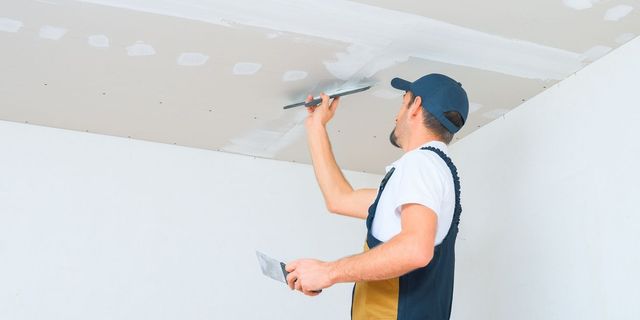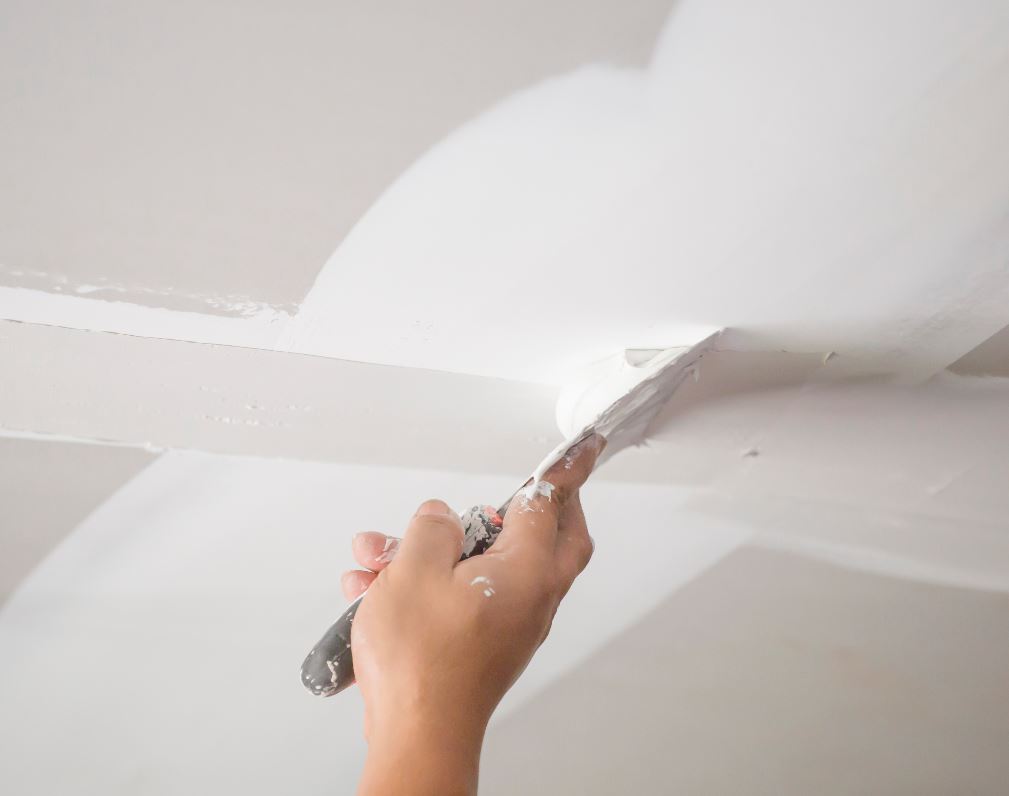Crucial Tips for Effective Drywall Repair and Setup Strategies
Effective drywall repair and installment calls for a mindful strategy. Recognizing the sorts of drywall and having the right devices is crucial. Proper methods and accurate dimensions can considerably affect the result. Lots of forget important steps like taping and sanding, which can make or break the last look. As jobs proceed, typical obstacles may occur that require focus. Discovering these suggestions can cause a more polished and successful surface.
Recognizing Different Kinds Of Drywall
Comprehending the different kinds of drywall is necessary for any type of successful repair or setup task. Drywall, typically recognized as gypsum board, can be found in several selections tailored for certain applications. Standard drywall is one of the most widely made use of type, perfect for basic indoor walls and ceilings. Moisture-resistant drywall, commonly green in color, is developed for locations prone to humidity, such as washrooms and kitchens. Fire-resistant drywall, generally tinted pink or purple, is crafted to hold up against higher temperatures and is typically made use of in garages or near heaters. Additionally, soundproof drywall helps in reducing noise transmission, making it ideal for multi-family homes or tape-recording workshops. Specialty drywall, like cement board, is made use of in damp locations like showers or bathtub surrounds. Understanding these types assists in selecting the appropriate material for each job, guaranteeing resilience and efficiency out of commission or brand-new installments.
Crucial Devices for Drywall Repair Work and Installation
Having the right devices is essential for efficient drywall repair and installation. A top quality utility blade is crucial for cutting drywall sheets exactly. A drywall T-square assists guarantee straight edges, while a taping knife is required for using joint compound smoothly over joints. Furthermore, a drywall saw enables removing damaged areas or fitting drywall around fixtures.
For hanging drywall, a power drill with drywall screws is crucial, as it makes it possible for fast and secure installment. A level is also vital to validate that the drywall is straight and appropriately aligned. A fining sand block or post sander is vital for raveling joint substance once it has dried out. A measuring tape is critical for accurate measurements, preventing waste and making certain an appropriate fit. Geared up with these devices, individuals can deal with drywall jobs properly, leading to professional-looking results.
Step-by-Step Guide to Repairing Holes and Cracks
When dealing with holes and fractures in drywall, having the right devices and materials is vital for an effective repair work. This guide details the essential items and provides a clear, step-by-step procedure to effectively bring back the surface area. Recognizing these components will certainly aid guarantee a seamless surface and resilient outcomes.
Tools and Materials Needed
A fully equipped toolkit is essential for reliable drywall repair work and setup. Secret devices consist of an energy knife for cutting drywall, a tape action to assure precise sizing, and a drywall saw for bigger openings. A putty blade is vital for using joint compound smoothly, while a sanding block or pole sander assists accomplish a smooth coating. For patching, a roll of fiberglass mesh tape or paper tape is necessary to reinforce joints. In addition, a drill and screws are needed for protecting brand-new drywall items. Crucial materials consist of joint substance, guide, and paint to finish the repair. Having these devices and products accessible assures a smoother, more efficient repair service process, yielding professional-looking outcomes.
Repair Work Process Actions
Repairing openings and cracks in drywall calls for an organized method to assure a smooth surface. Initially, the location surrounding the damages ought to be cleaned extensively to eliminate from this source dirt and debris. Next off, for tiny cracks, a putty knife is made use of to apply a joint substance equally over the location. For bigger holes, a spot is essential; the damaged section is cut out, and a brand-new item of drywall is suited area, secured with screws. Once the spot is in setting, joint compound is applied to blend the sides. After drying out, fining sand the location smooth is necessary. Ultimately, the fixed surface must be topped and painted to match the bordering wall, making sure an inconspicuous repair work.
Techniques for Putting Up Drywall Panels
Installing drywall panels requires careful planning and exact implementation to assure a professional and smooth coating. First, it is important to gauge the wall space precisely and reduce the panels to fit, ensuring that they align with the studs. Placing the panels horizontally is commonly suggested, as this can boost the architectural honesty and lower the variety of joints.
Making use of drywall screws, installers must safeguard the panels every 16 inches along the studs, ensuring a firm hold. It is vital to avoid overdriving the screws, which can harm the paper surface. For edges and corners, using an utility blade permits for tidy cuts and a snug fit.

Finishing Touches: Taping, Mudding, and Fining sand
Once the drywall panels are safely in position, the following crucial step includes the complements of taping, mudding, and sanding. Insulation is vital for developing a smooth change in between panels and hiding joints. A high quality drywall tape, either paper or fiberglass mesh, should be used over the seams, ensuring it adheres correctly to the mud that will certainly be used next.
Mudding, or applying joint compound, follows the taping process. This substance loads voids and smooths out the surface area. An initial coat should be applied generously, feathering the edges to blend with the drywall. After the preliminary layer dries, succeeding layers may be required for top article a flawless coating.
Finally, sanding is needed to accomplish a smooth surface area. A fine-grit sandpaper needs to be used to delicately ravel any type of blemishes. Care must be required to avoid over-sanding, which can harm the drywall - Interior Painting. Effectively performed, these completing touches create a specialist appearance prepared for paint
Tips for Maintaining Your Drywall After Setup
Preserving drywall after setup is crucial to preserving its appearance and architectural integrity. Routine cleansing is needed; dust and dust browse around these guys can gather, so mild cleaning with a moist cloth is recommended. House owners ought to additionally inspect for any indications of dampness or mold and mildew, specifically in high-humidity locations like restrooms and cooking areas. If any kind of damage takes place, it is necessary to address it without delay to stop more concerns.
Making use of furniture pads can assist avoid scrapes or damages from heavy things. Furthermore, painting the drywall with a premium, washable paint gives an added layer of defense and makes future cleansing less complicated. Prevent utilizing rough cleansers or devices, as these can damage the surface. Ultimately, maintaining a secure indoor environment with suitable moisture levels will aid protect against buckling or splitting in time. By complying with these tips, one can assure that drywall stays in outstanding problem for years to find.
Frequently Asked Concerns
How Much Time Does Drywall Take to Completely Dry After Installation?

Can I Set Up Drywall Over Existing Drywall?
Yes, drywall can be mounted over existing drywall, yet it is vital to guarantee the underlying surface area is safe and secure and appropriately prepared. This approach can improve insulation and decrease setup time, though it may add weight.
What Is the most effective Method to Soundproof Drywall?
The most effective means to soundproof drywall includes making use of specialized soundproofing products, such as resilient channels, acoustic caulk, and sound-dampening drywall. These methods properly decrease sound transmission in between spaces, enhancing general acoustic efficiency in living areas.
Just how Do I Pick the Right Drywall Density?
To pick the appropriate drywall thickness, consider the application and location. Requirement property walls commonly use 1/2 inch, while ceilings or specialized areas may need 5/8 inch for extra strength and soundproofing capabilities.
Exist Eco-Friendly Drywall Options Available?
Yes, green drywall options are readily available. These consist of items made from recycled materials, gypsum boards with reduced unstable natural compounds (VOCs), and those utilizing lasting manufacturing procedures, providing environmentally-conscious selections for building and remodelling projects.
Having the right devices is vital for effective drywall repair work and installation. For hanging drywall, a power drill with drywall screws is essential, as it allows fast and protected setup. Key devices include an utility blade for reducing drywall, a tape step to assure accurate sizing, and a drywall saw for larger openings. Yes, drywall can be set up over existing drywall, but it is crucial to guarantee the underlying surface area is safe and sufficiently prepared. The finest means to soundproof drywall includes making use of specialized soundproofing products, such as resistant channels, acoustic caulk, and sound-dampening drywall.